Mini PCs are used for a variety of purposes. For many applications, the Mini PC Graphics Card is critical. When selecting a Mini PC, it is possibly more important than the processor or memory unless you are looking at a very inexpensive mini pc.

Here’s why.
Key Takeaways:
- Compatibility Is Key: When selecting mini pc graphics cards, ensure compatibility with your mini PC’s form factor, power supply, and cooling capabilities. This includes checking PCIe slot availability and dimensions to avoid physical and electrical mismatches.
- Integrated vs. Dedicated: Understand the difference between integrated graphics, which are built into the CPU and suitable for basic tasks, and dedicated GPUs, which offer superior performance for gaming and graphic-intensive applications but may require more space and power.
- Performance Expectations: Set realistic expectations for the performance of mini pc graphics cards, considering the balance between the compact size of mini PCs and the power and heat management challenges they present.
- Future-Proofing: Opt for graphics cards that offer a good balance of performance and power efficiency, keeping in mind future upgrades and the evolving demands of software and games to ensure your mini PC remains relevant and capable.
Once you get to a certain price point, most mini pcs come with at least enough memory, storage and a fast enough CPU to support gaming or other graphic intensive applications. Especially for gaming, what you need are multiple, fast displays. And that is where the right graphics card comes in. The standard mini PC graphics cards like the Intel UHD graphics will fail to work with the best games (called AAA titles) and most gamers will be lost with only two 4K monitors, if the graphics card even supports that.
Most gamers want at least three 4k Monitors. And those monitors better be more like 120Hz, not 60Hz. And maybe four or five monitors with at least one 8K monitor.
So what to do? Let’s explore the options. As you will see, this is more like going to a car showroom and understanding the difference between a V6 and a V8. It’s mostly working backwards knowing what kind of graphics card you want and finding a mini PC that supports it.
There are a lot of graphics cards on the market. We’re not going to go through all of them.
I picked 5 that represent the market up to around what a mini pc in the $2000-$2500 might have. To get much beyond that frankly I think what they are calling a mini pc is in name only.
Look at the most expensive one here that calls itself a mini pc.
It weighs almost 20 pounds and is over a foot tall, vs 2-5 pounds and 2-4″ tall for what I have seen as a true mini pc.
Note: This article contains affiliate links. As an Amazon Affiliate, I may make commissions from your purchases. There is no extra cost to you and it helps to support this blog.
Mini PC Graphics Cards: Buy Or Upgrade?
Mini PCs with Integrated Graphics
Many mini PCs come with integrated graphics, meaning the GPU is built into the motherboard or processor and cannot be upgraded or changed. In such cases, you’re essentially looking for mini PCs that already come with the desired level of graphics performance built-in. This category often includes very compact, low-power devices designed for basic computing tasks, media consumption, and light productivity.
Mini PCs with Dedicated GPU Slots
A smaller subset of mini PCs is designed with expandability in mind, including some models that can accommodate dedicated GPUs.
The thrill of upgrading your mini PC with a new graphics card comes with the primal need for assurance – will it fit?
The quest for compatibility doesn’t end with a mere glance at dimensions. The universe of mini pc graphics cards is defined by form factors – the blueprint of your GPU’s size and layout. It’s my job to ensure you understand how to navigate these measurements, to find a card that aligns with the compact reality of your mini PC case.
Equally critical to a successful match is the PCIe interface – the bridge between your motherboard and the new GPU. But beware, not all PCIe slots are created equal. The version and slot size, often overlooked, are pivotal in the seamless integration of your chosen graphics card. An incompatible card can render itself an elaborate paperweight.
Fear not. You can arm yourself with knowledge. Gauge your mini PC’s internal landscape with precision; a simple tape measure can save you a world of frustration. Take note of the dimensions of the available space, and cross-reference that with the graphics card’s specifications. Remember, physical fit is a non-negotiable.
Lastly, don’t just count on luck; meticulousness is your ally. Check, double-check, and possibly triple-check the compatibility of the form factor, PCIe slot, and dimensions with your mini PC model before committing to buy.
These mini PCs often have:
- PCIe Slots: A PCIe slot is necessary for installing a dedicated graphics card. The availability and size of these slots (e.g., PCIe x16) in a mini PC determine what kind of GPU can be installed.
- Form Factor Considerations: Even if a mini PC has a PCIe slot, the physical space inside the case and the power supply’s capacity are critical factors. Only compact or “mini” versions of graphics cards, designed specifically to fit in smaller spaces, are suitable for these PCs.
- Thermal Management: High-performance GPUs generate a lot of heat. Adequate cooling is essential, especially in a compact space, to prevent overheating.
Choosing and Upgrading
- For Upgradability: If you’re interested in a mini PC with the option to upgrade the GPU, you’ll need to look for a model that supports PCIe-based dedicated graphics cards. These are usually more extensive and more expensive than their integrated graphics counterparts but offer more flexibility for gaming, graphic design, and video editing.
- Pre-built Mini PCs with Dedicated GPUs: Some manufacturers offer mini PCs with dedicated, often custom, GPUs. These systems are designed to balance performance with the form factor, providing a good solution for users who want more graphics power without the hassle of custom upgrades.
Balancing Power and Performance in Mini PC Graphics Cards
A mini PC’s charm is its compact size, but it’s crucial not to overlook the power constraints that come with this smaller form. Choosing a graphics card that aligns with your mini PC’s power supply isn’t just smart; it’s a necessity for stability and longevity. Let’s break this balance down further.
First, you need to be aware of your mini PC’s power supply unit (PSU) and its wattage. A common mistake is selecting a graphics card that demands more power than the PSU can deliver, leading to system crashes or, worse, hardware damage. Allocate sufficient power to your graphics card without overtaxing your mini PC’s power resources by comparing the wattage requirements of your chosen GPU against the PSU’s total wattage.
A graphics card’s power consumption, typically measured in watts, directly impacts your choice. Manufacturers often list the ‘TDP’—Thermal Design Power—which gives you an insight into both the heat generated and power consumed. For mini PCs, cards with lower TDP are beneficial as they consume less power and produce less heat, but keep performance in mind.
Finding a balance means weighing the demanding nature of today’s graphics-intense programs against the power-efficient traits you need. It may seem appealing to install a top-tier card, but this can turn sour if your mini PC’s PSU can’t keep up. This is where power efficiency ratings come in. Graphics cards with better efficiency ratings will give you more bang for your electrical buck.
But don’t get caught in the wattage web alone. To avoid restrictions on your future aspirations for your mini PC, consider the potential need for upgrading your PSU to accommodate a more powerful graphics card, if the form factor allows it. Remember, upgrading the PSU could be necessary for sustaining enhanced graphical performance down the line.
Your homework doesn’t end at power. The heat that comes with the power use of graphics cards is a reality, especially in the confined quarters of a mini PC. In the next section, I will guide you through the heat management strategies vital for maintaining a cool system.
Mini PC Graphics Cards: Five Cards That Balance Cost and Performance
Here are five mini pc graphics cards that you should consider, from the least expensive to the most performant. The mini PCs will usually tell you two things. What GPU the mini PC comes with, and whether or not it is upgradable. If you don’t want to change or install a GPU or have fallen in love with a certain mini PC and want to make sure it does what you want, here are 5 graphics cards to look for.
Note: When selecting a GPU for a mini PC, it’s crucial to consider not just the performance and price but also the physical dimensions, power requirements, and cooling capabilities of the GPU in relation to your mini PC case and power supply. Always ensure compatibility before purchasing. Which is why it may be better to select a mini PC that already has the graphics card you’re interested in.
1. Best Economy GPU for Mini PCs: Intel Iris Xe Graphics
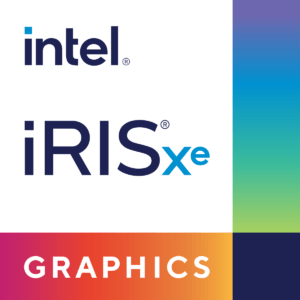
- Overview: Intel Iris Xe Graphics represent a significant leap forward for integrated GPU performance. Found in the latest Intel CPUs, Iris Xe can feature up to 96 execution units, utilizing system RAM (DDR4 or DDR5) to push the boundaries of what integrated graphics can achieve. Suitable for gaming and content creation, Iris Xe Graphics support multiple monitors—usually up to three—with 4K resolution at 60Hz. This high-performance GPU is a testament to Intel’s commitment to enhancing integrated graphics, offering impressive capabilities for users who prioritize efficiency and compactness without compromising on graphics performance.
- Why it’s great for Mini PCs:
- Its integration within the CPU saves space and power, making it ideal for compact mini PCs without compromising on basic gaming capabilities.
- Suitable for casual gaming, light content creation, and multimedia consumption
- Not suitable for high-end gaming at high resolutions or settings; performance heavily depends on the CPU model and system configuration.
- Price Range: Since it’s integrated, the cost is tied to the processor, but overall, systems with Iris Xe are generally more affordable, typically the most budget-friendly option among current GPUs suitable for mini PCs.
2. Mid-Range Entry: AMD Radeon 680M
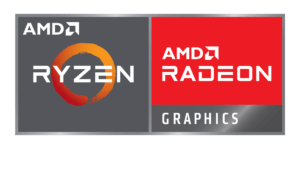
- Overview: The AMD Radeon 680M, integrated within AMD’s Ryzen mobile processors, marks a significant step up in performance. Designed to cater to light gaming and productivity tasks, the Radeon 680M leverages up to 12 GPU cores to deliver a robust graphics experience. This GPU shares system memory, supporting both DDR4 and LPDDR4, depending on the system’s configuration. Its ability to support multiple displays, typically up to four, with 4K resolution at 60Hz, positions it as a compelling option for users seeking enhanced graphics performance in a compact form factor.
- Why it’s great for Mini PCs:
- Offers superior integrated graphics performance in a compact form factor, enhancing gaming without needing a discrete GPU.
- Capable of running modern games at 1080p with medium settings, offering a significant improvement over previous integrated GPUs.
- Supports up to four displays, with resolutions up to 4K, depending on the APU and motherboard capabilities.
- While powerful for an integrated GPU, it cannot match the performance of mid-range discrete GPUs in demanding games and high settings.
- Price Range: Mini PCs with this GPU are moderately priced
3. Solid Mid-Range: NVidia RTX 3050
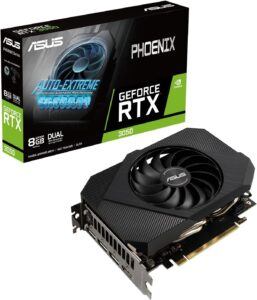
- Overview: The NVIDIA RTX 3050 elevates the gaming experience in mini PCs to new heights. With up to 2048 CUDA cores and 4GB or 8GB of GDDR6 memory, the RTX 3050 is a powerhouse capable of handling demanding games and professional-grade creative software. Its support for ray tracing further enhances its appeal to gamers and creators alike. The RTX 3050’s ability to drive up to four displays, with support for 8K resolution at 60Hz or 4K at 120Hz+, underscores its high-end status. Despite its power, the RTX 3050’s TDP is efficiently managed, ranging from 35W to 90W, ensuring that it fits within the compact and efficient ethos of mini PCs.
- Why it’s great for Mini PCs:
- Brings ray tracing and DLSS to small form factor PCs, enabling better gaming experiences without requiring a large chassis.
- Delivers solid 1080p gaming performance with support for ray tracing and DLSS, enhancing visual quality and frame rates in supported titles.
- Can support up to 4 displays simultaneously, with resolutions up to 7680×4320 (8K) using DisplayPort 1.4a.
- Its performance in ray-traced games at high settings can be limited, and it may struggle with 1440p and higher resolutions in more demanding titles.
- Price Range: Mini PCs equipped with the RTX 3050 fall into the mid-range category offering great value for gamers and creators who need more power without venturing into high-end pricing.
4. Upper Mid-Range: Intel Arc A770M
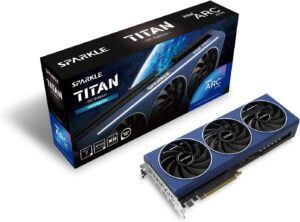
- Overview: The Intel Arc A770M is a high-end mobile GPU designed to deliver exceptional graphics performance for gaming and content creation. Equipped with 32 Xe-Cores and 16GB of GDDR6 memory, it offers robust computational power and ample memory bandwidth to handle demanding applications and games at high settings. The A770M supports advanced features such as ray tracing and AI-driven super sampling, enhancing visual fidelity and performance efficiency. With support for up to 8K resolution displays and the ability to drive multiple monitors, the Arc A770M is tailored for users seeking premium graphics capabilities in laptops and compact PCs. Its architecture is optimized for power efficiency, ensuring a balance between performance and energy consumption, making it a compelling option for high-performance mobile computing.
- Why it’s great for Mini PCs:
- Provides a new option for compact gaming rigs, promising good performance per watt and innovative features for gamers.
- Targets high-performance gaming at 1080p and 1440p, with the capability to run many games with ray tracing enabled.
- Capable of supporting multiple displays with high resolutions, though specific numbers depend on the laptop or mini PC implementation.
- As a new entry in the market, driver support and game optimization may not be as mature as competitors, potentially affecting performance in some titles.
- Price Range: Being relatively new, pricing can vary, but systems featuring this GPU are expected to be in the mid to high range, it’s for those willing to invest in significant gaming or creative work capabilities.
5. Best High-End GPU for Mini PCs: GeForce RTX 4070
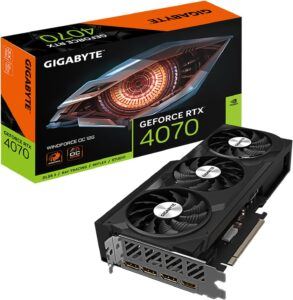
- Overview: The NVIDIA GeForce RTX 4070 is a cutting-edge GPU designed for gamers and creators seeking top-tier performance without venturing into the highest-end GPU territory. It features NVIDIA’s Ampere architecture, with a substantial number of CUDA cores and equipped with 12GB of GDDR6X memory, ensuring smooth gameplay and efficient data processing for demanding applications. The RTX 4070 incorporates advanced technologies such as real-time ray tracing and DLSS (Deep Learning Super Sampling), significantly enhancing visual quality and performance. It supports resolutions up to 8K and can efficiently manage multiple displays, making it ideal for immersive gaming setups and productive multitasking. With its focus on energy efficiency, the RTX 4070 strikes an excellent balance between power and consumption, catering to users who demand high performance in a more energy-conscious package.
- Why it’s great for Mini PCs:
- Despite its power, it’s efficient enough to be included in well-designed mini PCs, offering top-tier gaming experiences in a small package.
- Excellent for 1440p and capable of 4K gaming, with advanced features like ray tracing and DLSS for enhanced visuals and performance.
- Supports multiple displays, with at least 4K resolution support, and compatibility with DisplayPort 1.4a and HDMI 2.1 for high refresh rates and HDR.
- High-end performance comes with a higher price tag, and its power requirements might be a consideration for very compact mini PC designs.
- Price Range: Mini PCs with this GPU are on the high end. This is a premium option, priced for enthusiasts who demand top-tier performance in their mini PC builds.
Thermal Considerations: Keeping Your Mini PC Cool
Imagine cramming a powerhouse into a shoebox; that’s essentially what you’re doing when you slot a graphics card into a mini PC. It’s no surprise that managing heat becomes a critical issue. Adequate thermal regulation is essential not just for performance, but also for the longevity of your components.
In the tight quarters of a mini PC, traditional air cooling, often involving large heatsinks and fans, may not be a feasible option. This is where passive cooling solutions, such as heat pipes and heatsinks specifically designed for small form factors, come into play. They’re engineered to dissipate heat without moving parts, which means less noise and fewer points of failure.
However, for those pushing their systems with more demanding tasks, active cooling – a method involving fans that actively dissipate heat – remains necessary. The key is finding solutions that strike a balance between effective cooling and fitting within the confined space of a mini PC case.
Now, let’s not forget the role of case ventilation. Good airflow is nothing short of paramount. A well-ventilated case can be the difference between a system that hums along and one that overheats. Strategic placement of vents and, if space allows, small fans can help maintain a cool environment for your mini PC’s internal organs to operate effectively.
The introduction of a powerful GPU amplifies the need for a well-thought-out cooling strategy. While a mini PC might have been content with a simple fan and vent setup before, an upgrade to your graphics card could mean it’s time to revisit your cooling plan. A good practice is to check the GPU manufacturer’s recommendations and consider how they apply to your system’s form factor.
Transitioning to the next section, it’s crucial to understand that while managing heat is about maintaining operability, it’s also in service of performance. Heat is the enemy of speed and reliability. When looking into the graphics capabilities of a mini PC, don’t merely consider the specs; take into account how well the system can sustain those specs under load. This consideration smoothly sets the stage for our next focus: setting realistic performance expectations for mini PCs tailored to graphics-intensive tasks.
Managing Expectations: Mini PC Graphics Performance
When you’re assembling or upgrading a mini PC, managing performance expectations is key. High-end gaming rigs or video editing workstations might not be realistic goals, but that doesn’t mean you should settle for subpar visuals or stuttering playback.
Gaming on a mini PC isn’t out of reach. Look for graphics cards that strike a balance between size and capability. You might not run the latest titles on ultra settings, but with the right card you can enjoy a satisfying experience on medium settings. Understand the specs that matter: VRAM, clock speeds, and core counts contribute significantly to performance.
Video editing and other GPU-intensive tasks need a careful approach. Mini PCs can handle these, provided you choose a graphics card that aligns with your software’s requirements. For instance, Adobe Premiere Pro users should prioritize GPUs with ample CUDA cores or those well-optimized for hardware acceleration.
Get familiar with graphics settings. Sometimes, a little tweak here and there can substantially improve performance on a mini PC. This may involve reducing shadow quality, turning off anti-aliasing, or adjusting the resolution. Fine-tuning these settings can lead to better frame rates and a smoother user experience.
Lastly, look at real-world benchmarks rather than solely relying on theoretical performance numbers. Read reviews, watch test videos, and explore user forums for insights on how graphics cards actually perform in mini PCs just like yours.
Up next, you need to consider how you’ll connect your peripherals and displays. Connectivity options on mini PC graphics cards vary, and I’ll guide you through choosing what’s right for you and your setup.
Connecting Your World: Ports and Displays for Mini PCs
When I hunt for the right graphics card for a mini PC, I pay close attention to the available ports. This isn’t just about plugging things in; it’s about envisioning how my workspace or entertainment setup will come to life. HDMI, DisplayPort, and USB-C aren’t just jacks on a card; they define the experience.
If you’re like me and fancy a multi-monitor setup, then you really need to understand what each port offers. HDMI and DisplayPort are common, but DisplayPort often wins for daisy-chaining multiple displays. USB-C, on the other hand, is a rising star for its ability to carry power, data, and video—a trifecta of convenience that’s hard to beat.
And there’s another aspect to consider—streaming capabilities. As cloud gaming and high-definition streaming services gain popularity, the demand on your graphics card’s output quality surges. Some ports handle this better than others, so I always check the specifications to ensure they meet the requirements of the latest streaming platforms.
What I’ve come to appreciate is the importance of versatility. A graphics card with a variety of ports can save the day when you least expect it. Finally, it’s worth thinking ahead to avoid obsolescence. Pick a card with the latest version of these ports to make sure your mini PC can handle future tech advances.
As you shift focus from the dazzle of high-definition ports to the hunt for value, keep this mantra in mind: You’re not just buying for today; you’re investing in tomorrow. As you transition into the next section, you’ll see why finding a balance between cost and graphics performance is vital for the mini PC enthusiast who wants to maximize their investment without overstepping practical boundaries.
The Final Word: Smart Buying Decisions for Mini PC Graphics Cards
In the realm of mini PCs, making smart choices about graphics cards isn’t just about raw power; it’s about finding balance and foresight. It’s about scrutinizing the price-to-performance ratio and recognizing what’s a sound investment for your specific needs. As you weigh the options, consider not just the immediate gratification of higher frame rates or smoother editing workflows, but the long-term satisfaction of a system that’s been thoughtfully composed with components that truly fit together.
Start by admitting that space is a luxury and every square inch within your mini PC has to count. Be shrewd with your dollars, and remember that the smallest boost in performance often comes with a disproportionately higher price tag. That’s the nature of the miniaturization premium. The key advice here is to RESEARCH THOROUGHLY – look beyond the marketing and investigate user reviews, performance benchmarks, and teardowns to ensure you’re getting the best value.
Future-proofing is no less critical. Your mini PC might be mini, but your ambitions needn’t be. Planning for upgrades can save you from buyer’s remorse. Seek out flexibility in your graphics card choice, whether that’s in opting for a card with known upgrade paths or one that subscribes to standards that aren’t likely to vanish.
But let’s not forget the subtle aspects that contribute to your daily experience. Noise levels matter when your PC doubles as a workspace and entertainment unit. A loud fan can be more than just a nuisance; it can disrupt focus and intrude on relaxation. Moreover, having confidence in your brand choice because of strong customer support and reliable driver updates can transform the ownership experience from one of frustration to one of satisfaction.
Ultimately, remember that a mini PC graphics card is a commitment. It’s the bedrock of your digital ventures, big and small. Take your time, weigh these 10 crucial considerations I’ve shared, and choose NOT just for today, but for the countless moments you’ll depend on your mini PC to deliver both performance and pleasure. Whether you’re a tech enthusiast or an everyday user, the heart of your system deserves careful selection – so make it count.
Questions? We Have Answers.
Get answers to a list of the most Frequently Asked Questions.

I am a retired software engineer with experience in a multitude of areas including managing AWS and VMWare development environments. I bought a relative a mini-PC a year ago and have become passionate about the technology and its potential to change how we deploy software.
